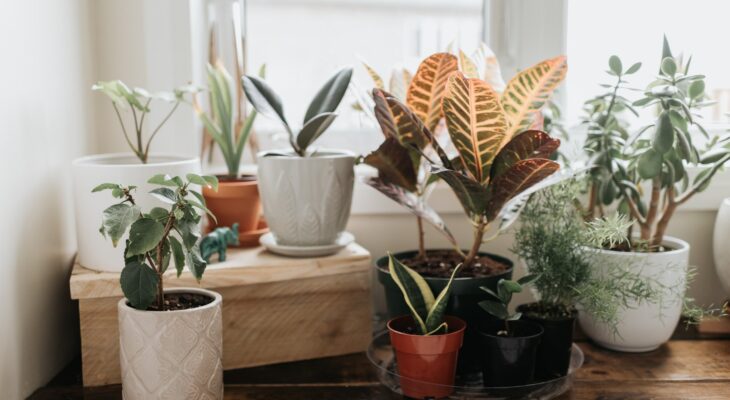Bringing the beauty of nature indoors not only enhances the aesthetics of your living space but also contributes to a healthier and more vibrant atmosphere. For beginners venturing into the world of indoor plants, the prospect of caring for green companions may seem daunting. Fear not! This guide will introduce you to a curated selection of low-maintenance indoor plants that are perfect for beginners. These resilient plants not only thrive with minimal care but also add a touch of greenery to your home effortlessly.
1. Snake Plant (Sansevieria Trifasciata): Renowned for its air-purifying qualities, the Snake Plant is a top choice for beginners. It tolerates low light conditions and infrequent watering, making it a resilient and adaptable companion. Its upright, sword-like leaves add a modern and sleek touch to any space.
2. Pothos (Epipremnum Aureum): Pothos, also known as Devil’s Ivy, is a versatile and forgiving plant that thrives in various light conditions. Its cascading vines and heart-shaped leaves make it an attractive addition to shelves or hanging baskets. Pothos is forgiving of irregular watering and can tolerate lower light levels.
3. ZZ Plant (Zamioculcas Zamiifolia): The ZZ Plant is a hardy and low-maintenance choice that thrives in low-light environments. With glossy, dark green leaves and an upright growth habit, it adds a touch of elegance to any room. ZZ Plants are drought-tolerant and can withstand periods of neglect.
4. Spider Plant (Chlorophytum Comosum): Spider Plants are known for their arching green and white striped leaves, creating a visually appealing display. These plants thrive in indirect light and are forgiving when it comes to watering. They also produce baby spider plants, known as “pups,” which can be propagated and shared.
5. Peace Lily (Spathiphyllum): The Peace Lily is not only a beautiful flowering plant but also an excellent air purifier. With dark green leaves and elegant white blooms, it thrives in low to moderate light conditions. Peace Lilies are relatively low-maintenance, requiring occasional watering when the soil is dry.
6. Aloe Vera (Aloe Barbadensis Miller): Aloe Vera is not only prized for its medicinal properties but is also an easy-to-care-for succulent. It thrives in bright, indirect light and requires minimal watering. A well-draining soil mix is essential for preventing overwatering and root rot.
7. Rubber Plant (Ficus Elastica): The Rubber Plant is a robust and resilient choice that adapts well to different light conditions, including lower light levels. With large, glossy leaves, it adds a touch of sophistication to your space. Allow the soil to dry out between waterings to keep your Rubber Plant happy.
8. Jade Plant (Crassula Ovata): Jade Plants are succulents with thick, fleshy leaves and are known for their resilience. They prefer bright, indirect light and can tolerate periods of drought. Jade Plants are symbols of good luck and prosperity, making them not only beautiful but also meaningful additions to your home.
9. Cast Iron Plant (Aspidistra Elatior): True to its name, the Cast Iron Plant is incredibly hardy and can withstand neglect, low light, and fluctuating temperatures. Its deep green, strappy leaves add a touch of elegance to corners or shaded areas of your home.
10. Haworthia (Haworthiopsis Attenuata): Haworthia, often referred to as the “Zebra Plant” due to its unique striped patterns, is a small succulent that thrives in bright, indirect light. It’s forgiving of occasional neglect and prefers well-draining soil to prevent waterlogged roots.
11. Chinese Evergreen (Aglaonema): Chinese Evergreens are known for their tolerance to low light and diverse leaf patterns. They come in various shades of green, silver, and red, adding a decorative element to your space. Allow the soil to dry out slightly between waterings.
12. Philodendron (Heartleaf Philodendron): The Heartleaf Philodendron is a classic and popular choice for beginners. With heart-shaped, trailing vines, it’s perfect for hanging baskets or placed on shelves. This plant is adaptable to various light conditions and forgiving of occasional lapses in watering.
Tips for Success with Low-Maintenance Plants:
- Light Requirements: Understand the light requirements of your chosen plants. Most low-maintenance options thrive in indirect or moderate light, making them suitable for a variety of indoor spaces.
- Watering Consistency: While these plants are low-maintenance, consistent watering is crucial. Allow the soil to dry out between waterings, and be mindful not to overwater, as this can lead to root rot.
- Well-Draining Soil: Use a well-draining potting mix to prevent waterlogged roots. This helps maintain a healthy balance between moisture and aeration.
- Temperature Considerations: Most low-maintenance plants are adaptable to average indoor temperatures. Avoid exposing them to drafts, extreme temperature fluctuations, or prolonged periods of direct sunlight.
- Observation and Adaptation: Regularly observe your plants for signs of health or stress. Adjust care routines based on how your plants respond to their environment.
- Gentle Pruning: Periodically prune dead or yellowing leaves to encourage healthy growth. This also enhances the overall appearance of your plants.
- Avoid Overcrowding: Give your plants ample space to grow. Avoid overcrowding, especially if you have multiple plants in the same area.
In conclusion, introducing low-maintenance indoor plants to your living space is a rewarding and accessible way to connect with nature. These resilient plants not only enhance the aesthetic appeal of your home but also offer numerous psychological and health benefits. As you embark on your indoor gardening journey, remember that each plant has its unique needs, and learning from your plants’ responses is an integral part of the joyful experience of nurturing your green companions. Happy planting!









